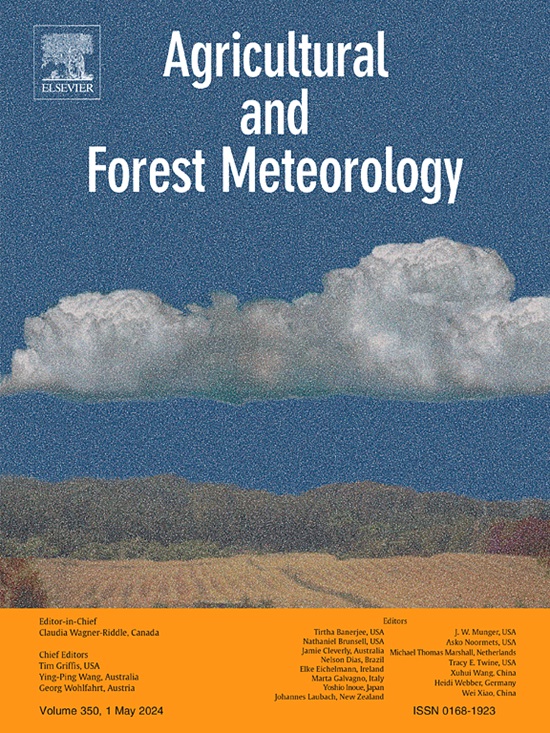Influence of forest canopy structure on temperature buffering in young planted forests with varied tree species compositions revealed by terrestrial laser scanning
IF 5.6
1区 农林科学
Q1 AGRONOMY
引用次数: 0
Abstract
Forest structure mediates below-canopy temperatures, creating unique microclimates for forest organisms. However, the understanding of how intricate forest canopy structure affect below-canopy air temperatures remains incomplete, especially in early-stage planted forests. Additionally, conventional forest structure metrics lack detailed structural information. We used 156 Terrestrial Laser Scanning single scans from 39 plots in a tree diversity experiment located at Zedelgem, Belgium, to explore how tree diversity and canopy structure affect below-canopy temperature. Five site-adapted species were planted, with plots varying in tree species richness from monocultures to four-species mixtures across twenty composition levels. Vertical plant profiles were derived from four scan locations per plot, allowing for the calculation of four variables to describe various aspects of forest canopy structure: foliage height diversity, total plant area index, canopy height, and canopy openness. Our findings showed that below-canopy temperature buffering was stronger in summer than in winter, with pine proportion dominating the buffering effect. Although canopy structure explained a small portion of the variance, it showed notable buffering potential, with summer cooling associated with low canopy openness and winter warming linked to high foliage height diversity and low canopy openness. Moreover, the community weighted mean specific leaf area, as an indirect proxy for transpiration potential, demonstrated strong summer cooling. Our findings suggest that local forest management strategies focused on temperature buffering should consider increasing pine proportions, as they enhance the buffering capacity in early forest development. As the forest matures, the advantages of a more diverse and denser canopy may become more apparent.
陆地激光扫描显示不同树种幼树林冠层结构对温度缓冲的影响
森林结构调节冠层以下的温度,为森林生物创造独特的小气候。然而,对复杂的森林冠层结构如何影响冠层下空气温度的理解仍然不完整,特别是在早期人工林中。此外,传统的森林结构度量缺乏详细的结构信息。在比利时Zedelgem的树木多样性实验中,利用156个陆地激光扫描单次扫描,探讨了树木多样性和冠层结构对冠层下温度的影响。种植了5种适应场地的树种,在20个组成水平上,从单一栽培到四种混合栽培的树种丰富度各不相同。垂直植物剖面来源于每个样地的四个扫描点,允许计算四个变量来描述森林冠层结构的各个方面:叶片高度多样性、总植物面积指数、冠层高度和冠层开度。结果表明:夏季林冠下温度缓冲作用强于冬季,以松木比例为主;尽管冠层结构解释了一小部分差异,但它显示出显著的缓冲潜力,夏季降温与低冠层开度有关,冬季增温与高叶高多样性和低冠层开度有关。此外,群落加权平均比叶面积作为蒸腾势的间接代表,表现出强烈的夏季降温作用。我们的研究结果表明,以温度缓冲为重点的地方森林管理策略应考虑增加松树的比例,因为它们可以增强森林早期发展的缓冲能力。随着森林的成熟,更多样化和更密集的树冠的优势可能会变得更加明显。
本文章由计算机程序翻译,如有差异,请以英文原文为准。
求助全文
约1分钟内获得全文
求助全文
来源期刊
CiteScore
10.30
自引率
9.70%
发文量
415
审稿时长
69 days
期刊介绍:
Agricultural and Forest Meteorology is an international journal for the publication of original articles and reviews on the inter-relationship between meteorology, agriculture, forestry, and natural ecosystems. Emphasis is on basic and applied scientific research relevant to practical problems in the field of plant and soil sciences, ecology and biogeochemistry as affected by weather as well as climate variability and change. Theoretical models should be tested against experimental data. Articles must appeal to an international audience. Special issues devoted to single topics are also published.
Typical topics include canopy micrometeorology (e.g. canopy radiation transfer, turbulence near the ground, evapotranspiration, energy balance, fluxes of trace gases), micrometeorological instrumentation (e.g., sensors for trace gases, flux measurement instruments, radiation measurement techniques), aerobiology (e.g. the dispersion of pollen, spores, insects and pesticides), biometeorology (e.g. the effect of weather and climate on plant distribution, crop yield, water-use efficiency, and plant phenology), forest-fire/weather interactions, and feedbacks from vegetation to weather and the climate system.

 求助内容:
求助内容: 应助结果提醒方式:
应助结果提醒方式:


